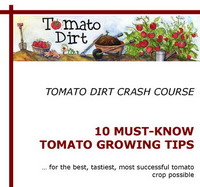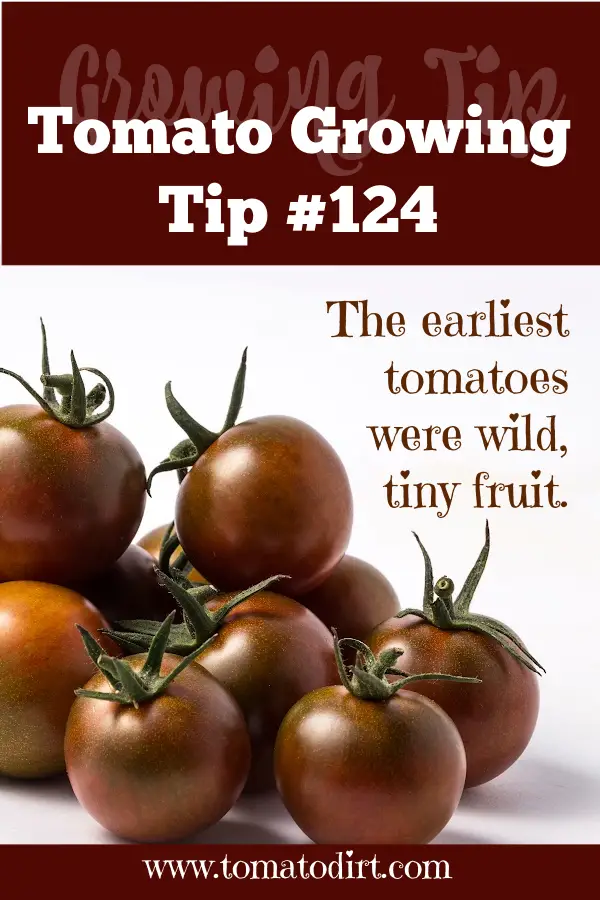FREE: 10 Must-Know Tomato Growing Tips Get The Guide
Read our affiliate disclosure here.
The Juicy History of the Tomato:
From Poisonous Berry to Global Favorite
Since 2010, Tomato Dirt has garnered 4.8+ million views, making it the web’s leading online source for growing tomatoes in the home garden. Award-winning writer and Tomato Dirt owner Kathy Widenhouse has helped thousands of home gardeners grow healthier tomatoes. Be one of them when you get Tomato Dirt’s Growing Guide here.
Updated 12.4.25
Tomatoes — they’re in your pasta sauce, your sandwiches, and your summer salads. It’s natural to think this kitchen staple has always existed in its present form.
But the history of the tomato is filled with twists, myths, and a few accidental discoveries along the way. In fact, not so long ago, people thought tomatoes were poisonous. Really.
Since then, the tomato has journeyed from wild berry to global superstar. Let’s dig into the flavorful history of the tomato and how this once-mysterious fruit won over the world.
Where did tomatoes come from?
Before tomatoes found their way into pasta sauce and pizza, they grew wild in the Andes Mountains of South America — today’s Peru, Ecuador, and northern Chile. These wild plants produced small, tart fruits that looked more like cherry tomatoes than the big red slicers we know today.
Indigenous peoples began domesticating them thousands of years ago, choosing plants that produced bigger, juicier fruits.
The tomato traveled north to Central America and Mexico. By the time the Aztecs were cultivating tomatoes in central Mexico, the fruit had already become a staple of their diet. They called it tomatl, meaning “plump fruit,” and used it in stews, sauces, and even beverages.
Who discovered tomatoes?
Technically, the Spanish conquistadors were the first Europeans to “discover” tomatoes when they explored Central America and Mexico in the 1500s. They carried seeds back to Europe.
But it was the Aztec and Mayan civilizations who had cultivated and loved tomatoes long before Europeans even knew they existed.
The history of the tomato in Europe
In 1519, Hernando Cortez introduced the tomato to Europe after his conquest of Mexico. By the mid-1500s, the tomato had been shared across Spain and Italy.
But instead of ending up in kitchens, the tomato landed in Europe’s ornamental gardens. Europeans admired the tomato plant for its bright fruit and exotic appearance — but feared eating it.
Why people
thought tomatoes were poisonous
Europeans admired the tomato’s beauty but distrusted its edibility — after all, it belonged to the nightshade (Solanaceae) family, which includes some genuinely toxic plants like belladonna. Many people assumed the tomato was poisonous too.
In northern Europe, that fear deepened when wealthy families who ate tomatoes off pewter plates fell ill. The real culprit was lead poisoning: the tomato’s acidity leached lead from the plates. But the tomato got the blame, earning it nicknames like “poison apple.”
In fact, 17th-century Brits, too, believed tomatoes were poisonous. The myth was promoted by herbalist John Gerard in his popular Gerard’s Herbal, published in 1597, even though he knew the Italians and Spaniards frequently ate tomatoes without ever being harmed.
How Italy fell in love with tomatoes
Despite its rocky start, the tomato found a welcoming home in the Mediterranean. Southern Europeans, particularly in Spain and Italy, began experimenting with the fruit in cooking. Warm climates helped the plant thrive.
Those first tomatoes were yellow. Italian physician and botanist Pietro Andrea Mattioli referred to them as the "pomi d'oro" or the "golden apple"(1544). Red tomatoes appeared later, compliments of two Jesuit priests returning from Mexico with red tomato seeds. Italians immediately accepted and included this strain of tomatoes in their cuisine.
By the late 1600s, Italians were sautéing tomatoes with onions and herbs — the earliest version of tomato sauce. The first known tomato recipe appeared in a Neapolitan cookbook in 1692.
Over the next century, tomatoes became essential in Italian cuisine. By the 1800s, they were the heart of Mediterranean cooking — the base of pasta sauce, pizza, and soups like minestrone.
So if you’ve ever wondered how the tomato became a key part of Italian food, the answer is simple: patience, experimentation, and a love of flavor.
The tomato crosses the Atlantic
(again)
While the tomato thrived in southern Europe, colonial America remained skeptical. Early settlers inherited European fears that tomatoes were dangerous and chose to use tomatoes as decorative, not edible.
That began to change in the early 1800s, thanks in part to adventurous gardeners. Thomas Jefferson brought back tomatoes from France when he served as U.S. Ambassador and grew them in his garden at Monticello in the early 1800s. The first tomato ketchup recipe was published in Pennsylvania in 1812. In the absence of refrigeration, users dried tomatoes in the sun.
One famous daredevil moment, it is said, changed American hearts and minds about the tomato.
In 1820, Colonel Robert Gibbon Johnson of Salem, New Jersey, allegedly stood on the courthouse steps in Salem, New Jersey, and ate a basket of tomatoes in front of a shocked crowd. Everyone expected him to drop dead. He didn’t. The crowd gasped, and word spread: tomatoes were safe.
By the mid-19th century, Americans were cooking with tomatoes regularly. And when canning technology arrived, tomato-based products like sauces, soups, and ketchup became pantry staples across the country.
Tomato origins summarized
- 700 BC–1500 AD: Indigenous peoples in South America and Mexico domesticate wild tomatoes.
- 1500s: Spanish explorers bring tomatoes to Europe.
- 1600s–1700s: Europe fears tomatoes as poisonous; Italians begin using them in cooking.
- 1800s: Tomatoes gain popularity in the U.S.; canning spreads their use.
- 1900s–Today: Tomatoes become a global crop and culinary staple.
The rise of the tomato industry
The history of the tomato cannot be complete without a summary of what has happened since the fruit became accepted.
The Industrial Revolution transformed tomato cultivation and consumption – from backyard crop to industrial powerhouse. In the late 1800s, companies like Heinz and Campbell’s began producing tomato-based foods on a massive scale — ketchup, condensed soups, sauces, canned tomatoes – that became pantry staples across the U.S.
This era marked the tomato’s true global spread. Immigrants from Italy, Spain, and Latin America brought tomato-rich dishes to North America and beyond.
Meanwhile, plant breeders developed new tomato varieties for higher yields, disease resistance, and easier transport – though, sadly, some flavor was lost along the way. Today, however, heirloom tomato lovers are bringing back the taste of history one seed at a time.
The tomato today
From backyard gardens to commercial farms, the tomato is now one of the world’s most widely grown crops — second only to the potato among vegetables.
- More than 170 countries produce tomatoes. You’ll find them in nearly every cuisine: Mexican salsas, Italian sauces, Indian curries, and Middle Eastern shakshuka all rely on the humble tomato.
- There are tens of thousands of tomato varieties— from tiny cherry tomatoes to rainbow-striped heirlooms — each with its own flavor and story.
- And they’re a favorite of home gardeners everywhere, thanks to their versatility, productivity, and irresistible flavor.
- In a sense, the tomato has come full circle. What started as a wild berry in South America is now one of humanity’s most celebrated foods — with a history as rich as its taste.
Every time you slice a tomato, you’re tasting 2,000 years of history — from the Andes to your dinner table.
Not bad for a fruit that almost didn’t make it.
Fun tomato fact
Tomato seeds are preserved in seed banks around the world, including the Svalbard Global Seed Vault, ensuring their survival for future generations.
In other words, the tomato is here to stay — forever.
More Tomato Facts
Tomato facts: fun information and trivia ...
Tomato nutrition facts: what nutrients are in tomatoes?
What are the health benefits of tomatoes?
What Vitamins Are In Tomatoes?
Best (and worst) tomato jokes ...
Take The Great Tomato Quiz ...
Tomato – fruit or vegetable? Find out ...
More tomato facts on our Pinterest board ...
Return from The Juicy History of the Tomato to Tomato Dirt home
As an Amazon Associate and Rakuten Advertising affiliate I earn from qualifying purchases.
SHARE THIS PAGE:
FREE! 10 Must-Know Tomato Growing Tips: 20-page guide
Get yours here:






